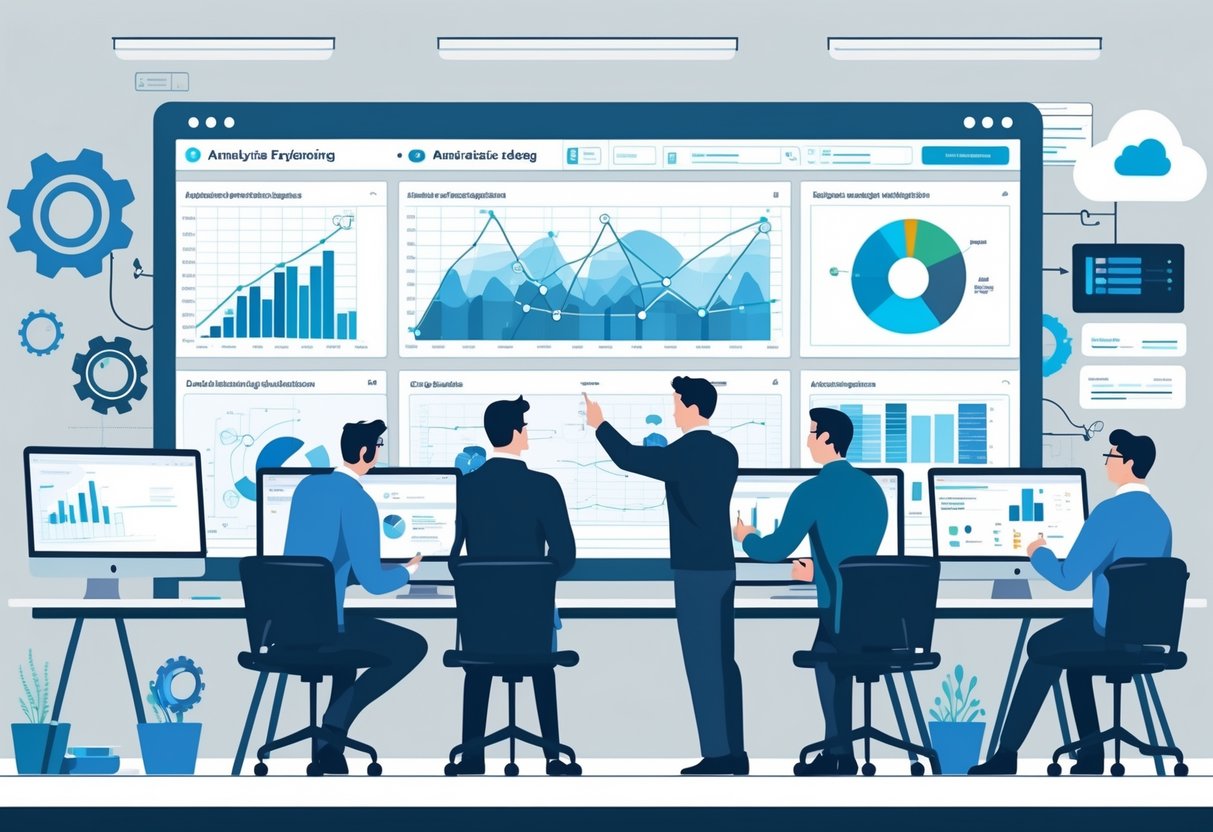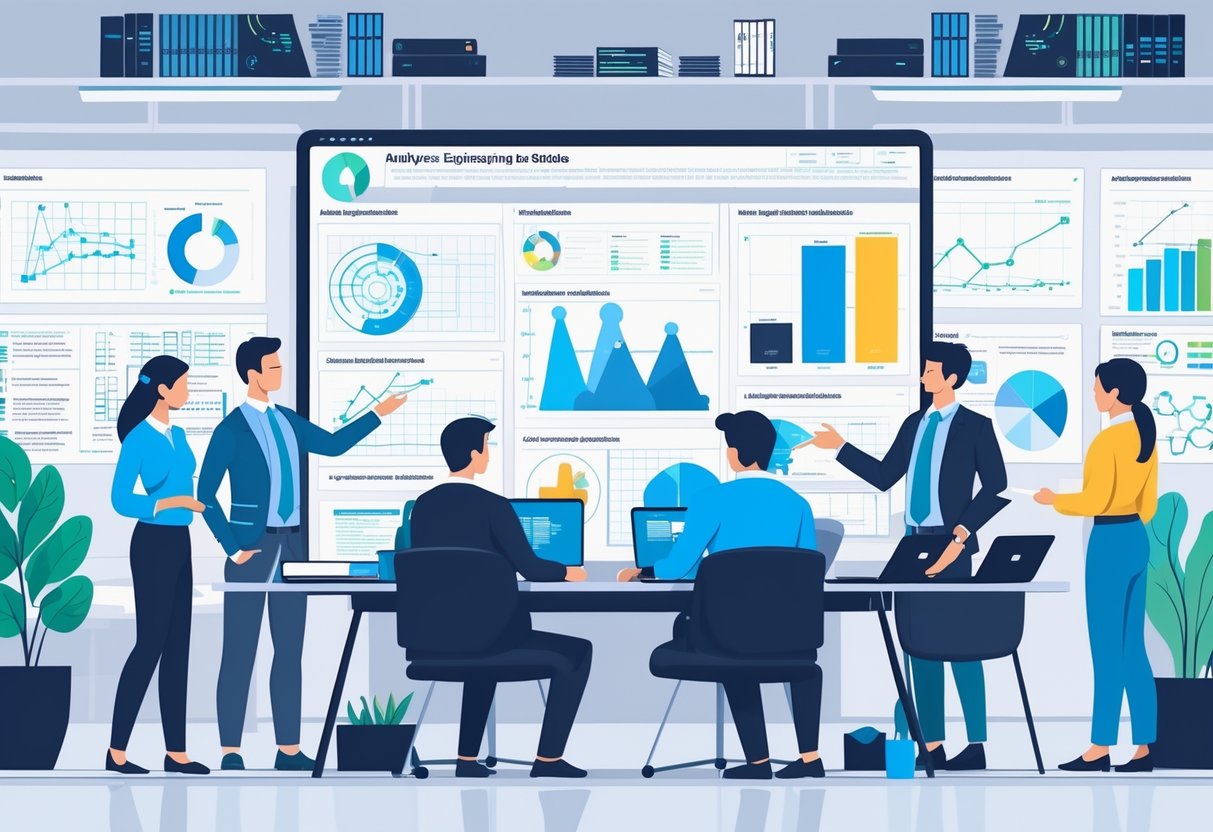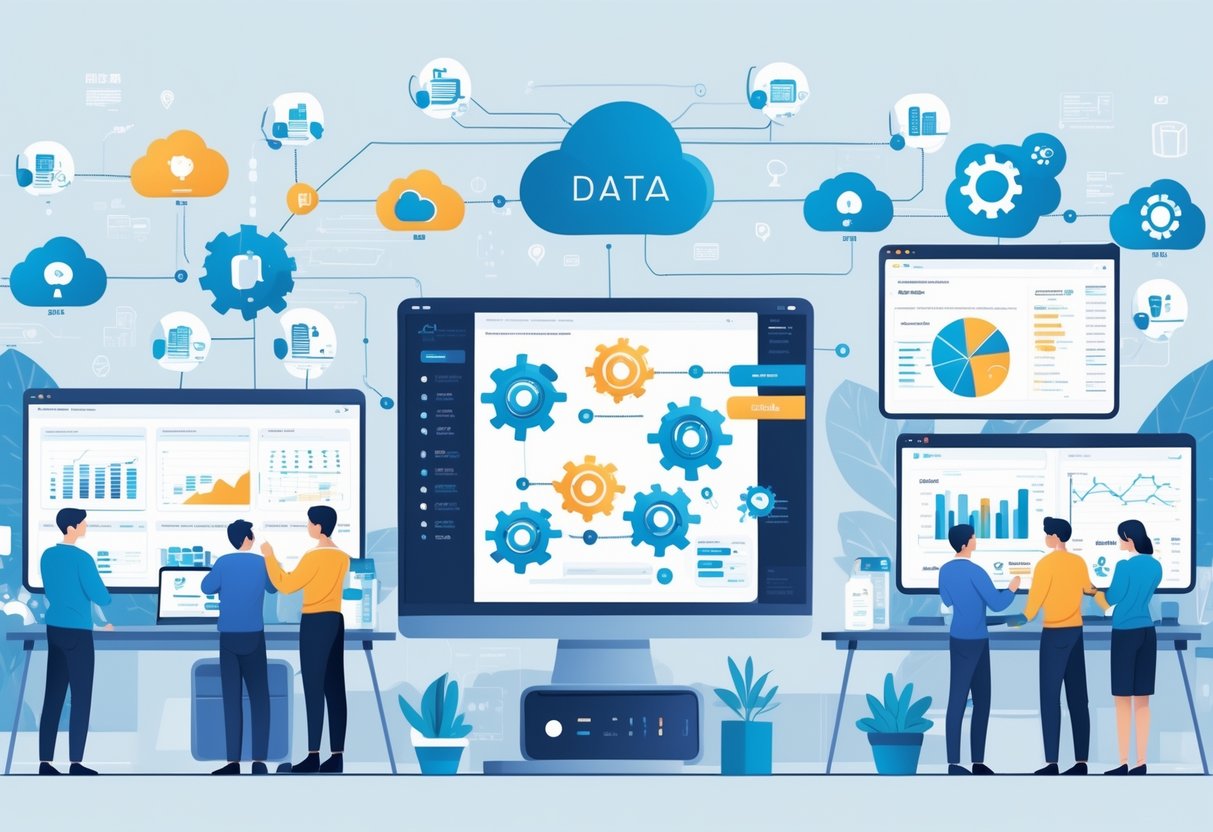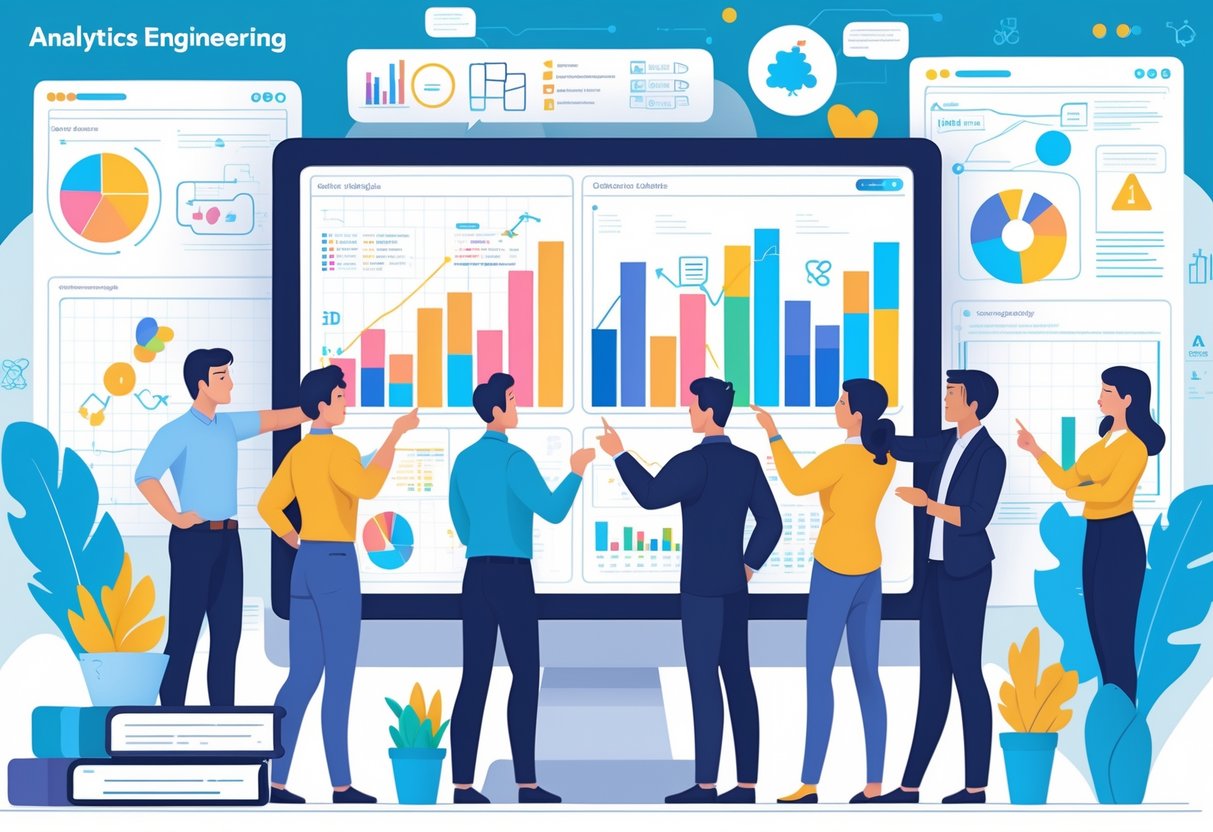Analytics engineering professionals face intense competition when showcasing their skills to potential employers and clients. A well-crafted case study serves as concrete proof of technical abilities and problem-solving skills that can set candidates apart in today’s data-driven job market.

A powerful analytics engineering case study demonstrates real-world impact through clear documentation of the complete data process, from initial collection through final insights and business outcomes. Unlike simple project descriptions, effective case studies tell a compelling story that highlights both technical expertise and strategic thinking. They show how data transforms into actionable business value.
The most successful case studies follow a structured approach that covers the entire analytics lifecycle while maintaining reader engagement. Building compelling data engineering case studies requires careful attention to methodology documentation, technology choices, and measurable results. This comprehensive guide explores each essential component needed to create case studies that capture attention and demonstrate professional capabilities.
Key Takeaways
- Structure case studies around complete data workflows from collection to business impact
- Document technical approaches and tools while maintaining clear storytelling throughout
- Include quantifiable results and visual elements to demonstrate real-world value
Understanding Analytics Engineering Case Studies

Analytics engineering case studies demonstrate how data professionals solve specific business problems through structured analysis, tool implementation, and measurable outcomes. These studies serve as learning tools for data analysts and provide frameworks for approaching similar challenges across different industries.
Defining an Analytics Engineering Case Study
An analytics engineering case study is a detailed examination of how data professionals used analytical methods to solve real business problems. It documents the entire process from problem identification to final results.
These studies include specific components that make them valuable learning tools. The problem statement outlines the business challenge that needed solving. The methodology section explains which analytical approaches and tools were chosen.
The implementation phase shows how data analysts executed their strategy. This includes data collection methods, cleaning processes, and analysis techniques used.
Results sections present measurable outcomes with specific metrics. They show how the solution improved business performance or solved the original problem.
Data analytics case studies typically follow this structure to help others understand and replicate successful approaches.
Purpose and Value for Data Analysts
Data analysts use case studies to learn proven methods for solving complex business challenges. These real-world examples show which techniques work best in different situations.
Case studies help analysts understand how to communicate findings to business stakeholders. They demonstrate effective ways to present data insights that drive decision-making.
Professional development benefits include exposure to new tools and methodologies. Analysts can see how others approached similar problems in their industry or related fields.
Key learning areas include:
- Problem-solving frameworks
- Tool selection criteria
- Data visualization techniques
- Stakeholder communication methods
Case studies also help analysts build portfolios that showcase their problem-solving abilities. They provide concrete examples of how analytical work creates business value.
Common Types of Business Challenges Addressed
Analytics case studies across different industries tackle various business challenges that organizations face regularly. These problems span multiple departments and business functions.
Marketing and Sales Challenges:
- Customer segmentation and targeting
- Campaign performance optimization
- Sales forecasting and pipeline analysis
- Pricing strategy development
Operational Efficiency Problems:
- Supply chain optimization
- Process improvement initiatives
- Resource allocation decisions
- Quality control monitoring
Customer Experience Issues:
- Churn prediction and prevention
- Personalization strategies
- Service quality measurement
- Product recommendation systems
Financial challenges include revenue optimization, cost reduction initiatives, and risk assessment projects. These case studies show how data analysts help organizations make better financial decisions.
Technology-focused studies examine system performance, user behavior analysis, and product development insights. They demonstrate how analytical work supports technical decision-making processes.
Structuring an Effective Case Study

A well-structured analytics engineering case study follows a logical framework that demonstrates measurable business impact. The framework must define clear project boundaries, identify key decision-makers affected by data-driven solutions, and showcase quantifiable results that address specific business challenges.
Establishing Clear Objectives and Scope
Analytics engineers must define specific, measurable objectives at the project’s start. These objectives should directly address business challenges through data analysis and technical solutions.
Project boundaries help readers understand what the case study covers and excludes. This prevents scope creep in the narrative and keeps focus on key deliverables.
Clear objectives typically include:
- Primary goal: The main business problem being solved
- Secondary goals: Supporting outcomes that enhance the primary objective
- Success criteria: Specific metrics that define project completion
- Timeline: Project duration and key milestones
The scope statement should specify which data sources, systems, and business units are included. It should also note any limitations or constraints that shaped the project approach.
A focused scope prevents the case study from becoming too broad or losing technical depth. This clarity helps potential employers understand the engineer’s ability to manage complex projects within defined parameters.
Identifying Stakeholders and Success Metrics
Stakeholder identification reveals who benefits from data-driven decisions and technical improvements. This section demonstrates the engineer’s understanding of business impact beyond technical implementation.
Key stakeholder categories include:
- Business users: Teams consuming analytics outputs
- Technical teams: Engineers maintaining or extending the solution
- Leadership: Executives making strategic decisions based on the data
- End customers: External users affected by improved data systems
Success metrics must be quantifiable and tied to business outcomes. These metrics prove the value of technical work through concrete measurements.
| Metric Type | Example | Business Impact |
|---|---|---|
| Performance | 50% faster query response | Improved user experience |
| Accuracy | 95% data quality score | Better decision making |
| Cost | 30% infrastructure savings | Reduced operational expenses |
Each metric should connect technical improvements to business value. This connection shows how analytics engineering directly supports organizational goals and data-driven decisions.
Presenting Key Learnings and Outcomes
The outcomes section showcases measurable results from the analytics engineering work. This section transforms technical achievements into business value that stakeholders can understand and appreciate.
Quantified results provide concrete evidence of project success. Numbers demonstrate impact more effectively than qualitative descriptions alone.
Results should include:
- Before and after comparisons showing improvement magnitude
- Timeline data revealing how quickly benefits were realized
- User adoption rates indicating solution acceptance
- Error reduction percentages proving quality improvements
Technical learnings help other engineers understand implementation challenges and solutions. These insights add credibility and show problem-solving abilities.
Key learnings might cover architecture decisions, tool selections, or process improvements that emerged during development. They should focus on choices that significantly impacted project outcomes.
Business impact statements connect technical work to organizational success. These statements help non-technical readers understand how data analysis and engineering improvements supported broader company objectives.
Each outcome should tie back to the original objectives and success metrics established at the project start.
Data Lifecycle: Collection, Cleaning, and Exploration

The data analytics lifecycle transforms raw information into actionable insights through three critical phases. Data collection establishes the foundation by gathering relevant information from multiple sources, while cleaning ensures accuracy and consistency for reliable analysis.
Data Collection Methods and Tools
Modern analytics engineering relies on diverse data collection strategies to build comprehensive datasets. Primary collection methods include surveys, transactional records, and IoT sensors that capture real-time information.
Web scraping tools like BeautifulSoup and Scrapy extract data from websites automatically. Database connections pull structured information from SQL systems and data warehouses.
API integrations enable seamless data flow from external platforms. Cloud services like AWS IoT Core and Azure Data Factory streamline collection processes across distributed systems.
| Collection Method | Tools | Use Case |
|---|---|---|
| Web Scraping | BeautifulSoup, Scrapy | Price monitoring, content analysis |
| IoT Sensors | Raspberry Pi, Arduino | Real-time monitoring, equipment tracking |
| APIs | REST, GraphQL | Social media data, financial feeds |
| Databases | SQL, NoSQL | Customer records, transaction history |
Analytics engineers must align data collection and analysis objectives with business requirements. This ensures collected information directly supports analytical goals and decision-making processes.
Data Cleaning and Preparation for Analysis
Data cleaning transforms raw datasets into analysis-ready formats through systematic error removal and standardization. Missing values require handling through imputation, deletion, or placeholder insertion based on data patterns.
Duplicate records skew analytical results and must be identified using unique identifiers or fuzzy matching algorithms. Data type conversions ensure consistency across columns and enable proper mathematical operations.
Format standardization addresses inconsistent date formats, currency symbols, and categorical variables. Outlier detection identifies extreme values that may indicate errors or genuine anomalies requiring investigation.
The data preparation stage typically consumes 60-80% of project time. Tools like pandas in Python and dplyr in R automate repetitive cleaning tasks.
Validation rules verify data quality through range checks, pattern matching, and cross-field consistency tests. Documentation of cleaning steps ensures reproducibility and transparency in the analytical process.
Conducting Exploratory Data Analysis
Exploratory data analysis (EDA) reveals hidden patterns, relationships, and anomalies within cleaned datasets. Summary statistics provide initial insights into data distribution, central tendencies, and variability measures.
Visualization techniques transform numerical data into interpretable charts and graphs. Histograms show distribution shapes, scatter plots reveal correlations, and box plots identify outliers and quartile ranges.
Correlation analysis quantifies relationships between variables using Pearson, Spearman, or Kendall coefficients. Heat maps visualize correlation matrices for quick pattern identification across multiple variables.
Hypothesis generation emerges from EDA findings and guides subsequent analytical modeling. Feature engineering opportunities become apparent through variable interaction analysis and domain knowledge application.
The exploratory data analysis phase informs model selection and analytical approach decisions. Interactive tools like Tableau, Power BI, and Jupyter notebooks facilitate iterative exploration and stakeholder communication.
Analytical Techniques and Modeling

Analytical modeling employs mathematical models, statistical algorithms, and data analysis techniques to transform raw data into actionable insights. Predictive analytics, correlation analysis, and machine learning integration form the core components that drive successful analytics engineering implementations.
Predictive Modeling in Case Studies
Building predictive analytics models requires a systematic approach that combines historical data patterns with statistical algorithms. Analytics engineers use these models to forecast future trends, identify potential risks, and optimize business processes.
Common predictive modeling techniques include:
- Linear regression for continuous variables
- Logistic regression for binary outcomes
- Time series analysis for temporal patterns
- Decision trees for classification problems
Python serves as the primary programming language for implementing predictive models. Libraries like scikit-learn, pandas, and NumPy provide the tools needed to build robust predictive analytics systems.
Data quality directly impacts model accuracy. Engineers must clean datasets, handle missing values, and validate input features before training begins. This preprocessing step often consumes 60-70% of the total modeling effort.
Applying Correlation Analysis and Histograms
Correlation analysis reveals relationships between variables that drive business outcomes. Analytics engineers use correlation coefficients to identify which factors influence key performance indicators most strongly.
Correlation strength interpretation:
- 0.7 to 1.0: Strong positive relationship
- 0.3 to 0.7: Moderate relationship
- 0.0 to 0.3: Weak relationship
Histograms visualize data distribution patterns and reveal outliers that could skew analysis results. These charts help engineers understand variable behavior before applying advanced modeling techniques.
Python’s matplotlib and seaborn libraries create effective histogram visualizations. Engineers can adjust bin sizes and apply statistical overlays to highlight distribution characteristics that impact model performance.
Integrating Artificial Intelligence and Machine Learning
Artificial intelligence, predictive modeling, and statistical analysis combine to create comprehensive analytics solutions. Machine learning models adapt to new data patterns without requiring manual programming updates.
Key machine learning approaches include:
- Supervised learning for labeled datasets
- Unsupervised learning for pattern discovery
- Reinforcement learning for optimization problems
Machine learning models require careful validation to prevent overfitting. Engineers split datasets into training, validation, and test portions to ensure models generalize effectively to new data.
Feature engineering transforms raw variables into meaningful inputs for machine learning algorithms. This process involves creating new variables, scaling numeric features, and encoding categorical data for optimal model performance.
Visualizing and Communicating Insights

Effective data visualization transforms raw analytics into clear, actionable insights while compelling storytelling ensures stakeholders understand and act on findings. Strategic presentation methods bridge the gap between technical analysis and business decision-making.
Data Visualization Strategies
Charts and graphs serve as the foundation for presenting analytics engineering findings. Bar charts work best for comparing categories, while line graphs excel at showing trends over time.
Heat maps effectively display sentiment analysis results across different time periods or customer segments. They make it easy to spot patterns in emotional responses to products or campaigns.
Interactive dashboards allow stakeholders to explore data insights at their own pace. Users can filter by date ranges, product lines, or geographic regions to find relevant information.
Key visualization types include:
- Scatter plots for correlation analysis
- Box plots for distribution comparisons
- Treemaps for hierarchical data
- Network diagrams for relationship mapping
Color choices matter significantly in data visualization. Use consistent color schemes throughout presentations to avoid confusion. Red typically signals problems while green indicates positive results.
Simple designs communicate better than complex ones. Remove unnecessary gridlines, legends, and decorative elements that distract from the main message.
Storytelling with Data Insights
Data storytelling combines numerical findings with narrative structure to create compelling presentations. Start with the business problem, present the analysis method, then reveal key findings.
Structure presentations with a clear beginning, middle, and end. The opening should establish context and explain why the analysis matters to the organization.
Use specific examples to illustrate broader trends. Instead of saying “customer satisfaction improved,” explain that “mobile app ratings increased from 3.2 to 4.1 stars after the checkout redesign.”
Effective data stories follow this framework:
| Element | Purpose | Example |
|---|---|---|
| Context | Sets the stage | “Sales declined 15% last quarter” |
| Conflict | Identifies the problem | “Mobile users abandoned carts frequently” |
| Resolution | Shows the solution | “New payment system reduced abandonment by 40%” |
Connect data insights to business outcomes. Explain how sentiment analysis findings led to product improvements or how customer behavior patterns influenced marketing strategies.
Avoid technical jargon when presenting to non-technical audiences. Replace terms like “statistical significance” with “reliable results” or “confidence intervals” with “expected ranges.”
Presenting Results for Stakeholder Engagement
Executive presentations require different approaches than technical team meetings. Focus on business impact rather than methodology details when addressing senior leadership.
Create multiple versions of the same presentation for different audiences. Data scientists need technical depth while executives want strategic implications.
Visual data storytelling tactics help convey actionable insights more effectively than spreadsheets or raw data dumps.
Presentation best practices include:
- Lead with conclusions, not methodology
- Use one key message per slide
- Include clear headlines that summarize findings
- Provide specific recommendations with timelines
Interactive elements increase engagement during presentations. Allow stakeholders to ask “what if” questions and show how different scenarios affect outcomes.
Follow up presentations with written summaries that include key charts and recommendations. This gives stakeholders reference materials for future discussions.
Practice presentations beforehand to ensure smooth delivery. Technical difficulties or unclear explanations can undermine even the strongest data analytics findings.
Frequently Asked Questions

Analytics engineering case studies require specific elements like problem statements, technical approaches, and measurable outcomes. Success depends on avoiding common mistakes while demonstrating clear business value through quantified results.
What are the key elements to include in an analytics engineering case study?
A strong analytics engineering case study needs a clear problem statement that defines the business challenge. The technical approach should detail the data sources, transformation processes, and tools used.
Results must include specific metrics and outcomes. Technical case studies require methodology sections that explain the step-by-step process.
Visual aids like architecture diagrams and data flow charts help readers understand complex systems. The technology stack section should list all tools, programming languages, and platforms used.
Key learnings and challenges faced during the project add depth. Timeline information shows project scope and complexity.
How can a business’s return on investment be quantified through analytics engineering case studies?
ROI quantification requires baseline measurements before implementing analytics solutions. Cost savings from automated processes, reduced manual work, and improved efficiency provide concrete numbers.
Revenue increases from better decision-making and faster insights demonstrate value. Time savings measured in hours or days can be converted to dollar amounts using employee hourly rates.
Error reduction percentages show quality improvements. Processing speed improvements measured in execution time or data throughput provide measurable benefits.
Customer satisfaction scores and retention rates may improve with better analytics. These metrics can be tied to revenue impact through established business calculations.
What are some common pitfalls to avoid when creating an analytics engineering case study?
Avoiding technical jargon without explanation prevents reader confusion. Analytics case studies need clear structure to guide readers through the narrative.
Focusing only on technical details without business context reduces impact. Missing quantified results makes it hard to assess project success.
Choosing projects without significant outcomes weakens the case study. Overly complex explanations can lose the reader’s attention.
Failing to include challenges and how they were overcome makes the project seem unrealistic. Not showing the complete process from problem to solution creates gaps in understanding.
Can you provide an example of a successful analytics engineering case study and its impact?
Supply chain optimization through predictive analytics demonstrates successful analytics engineering. The project used historical data to predict inventory needs and reduce waste.
The company built data pipelines to collect information from multiple sources. Machine learning models analyzed patterns in demand and supply fluctuations.
Results included 25% reduction in excess inventory and 15% improvement in stock availability. The system enabled data-driven decisions about product orders and promotions.
The analytics solution transformed the entire supply chain approach. Business growth accelerated through more efficient inventory management processes.
How does the integration of data science techniques enhance the value of an analytics engineering case study?
Data science techniques like machine learning add predictive capabilities to analytics platforms. Statistical analysis methods provide deeper insights from existing data.
Advanced algorithms can identify patterns humans might miss. Automated model training and deployment showcase technical sophistication.
Feature engineering demonstrates data preparation skills. Model validation techniques show rigorous testing approaches.
Real-time scoring systems highlight operational analytics capabilities. A/B testing frameworks prove the ability to measure impact scientifically.
What methodologies are most effective in conducting and presenting analytics engineering case studies?
The problem-solution-results framework provides clear narrative structure. Storytelling approaches engage readers while maintaining technical accuracy.
Agile development methodologies show iterative improvement processes. Data modeling techniques demonstrate systematic approaches to data structure design.
Version control practices highlight professional development standards. Testing methodologies prove solution reliability and accuracy.
Documentation standards ensure reproducible results. Performance monitoring approaches show ongoing system optimization capabilities.




